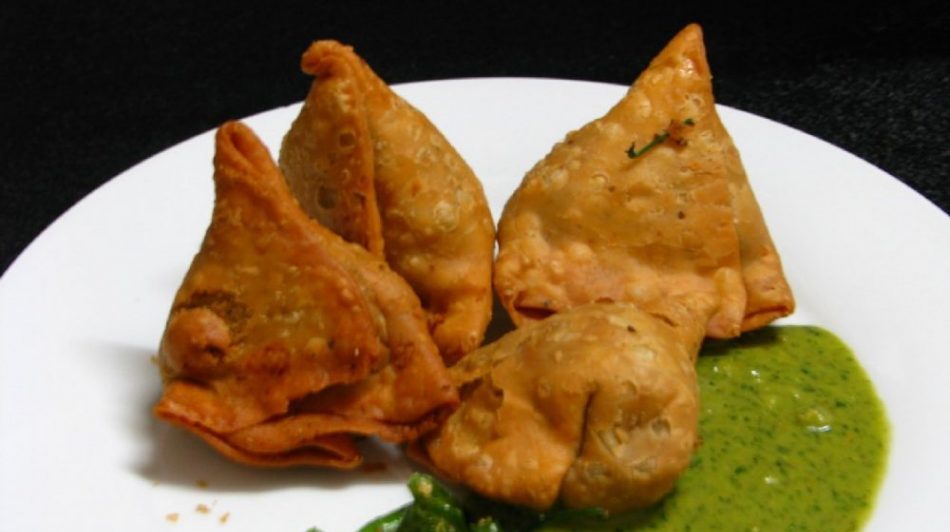Mama’s Punjabi Recipes – Samose (FRIED STUFFED PASTRIES)

If you go to any South Asian party, chances are that you’ll be served samosas for snacks. These pyramid shaped appetizers are even available in the frozen food sections in large, medium and cocktail sizes, have crossed over into the mainstream stores and the name has become part of the vernacular. Below is a reprint of Mama’s Samose recipe, which is perfect with chutney and hot tea. It is reprinted with some additional information and directions.
Here is another North Indian snack that has migrated not just to the rest of India but around the world. It is perhaps the most popular Indian snack due to its neat triangular appearance, variety of stuffings and flaky texture when cooked right. The closest Western snack to it is probably the empananda which is a baked, long, shell-shaped which originated in Spain and Portugal in the Moorish period of the 8th century and has made its way to Latin America.
In India, the corner store halweis (confectioners) generally make samosas for an afternoon tea snack, but in larger stores they are available all day. Some people will sometimes eat a whole meal of samosas rolled up in a roti, with a little chutney or with semi-dry chole (garbanzos) as a heavy appetizer. Samosas are usually made with maida (finely milled, refined and bleached wheat flour), like puff-pastries.
Although most people associate samosas with India, it may come as a surprise to learn that, just like sone halwa which came from Turkey, samosas originated before the 10th century in the Middle East where they are known as sambosa. They were introduced to India in the 13th or 14th century by Arab traders and are mentioned in the Mughal courts as sambusak.
Samosas are generally served hot and eaten with mint or imbli (tamarind) chutney. They now come in small bite size to serve with cocktails and of course, the large Punjabi style, usually stuffed with potatoes and peas.
Ingredients:
• 1 cup maida (fine bleached wheat flour)
• ½ cup pani (water) – enough to make the dough
• ¼ cup tael (vegetable oil)
• 1 lb aloo (potatoes) – avoid russet as the mash easily
• ¼ cup mutter (peas) – if frozen, then defrost first
• Spices to taste: namak (salt), mirch (red pepper), garam masala, dhania (coriander)
Directions:
1. Place the aloo in a medium pot full of water and bring them to a boil. When tender (but not mushy), remove the aloo, discard the water and let the aloo cool down.
2. Peel the aloo and chop into small pieces. Pour a tablespoon of oil into a skillet over medium heat and stir fry the potatoes till they are a little brown. Stir in the namak, mirch, dhania and garam masala to taste.
3. For the samosas shells, in a bowl, pour in the maida then add the oil and sprinkle in some warm water, mixing well to make the dough. Judge the amount of water needed so that the dough is semi-hard and not too soft otherwise the samosa shell will fall apart. Cover the dough and leave it covered for at least 30 minutes.
4. Take an inch round piece of dough and make a ball out of it. Now roll it out like a 1/8 inch thick roti and cut into half.
5. With your hand, form a holder between your fingers and your thumb. Place the half-cut dough in this cavity and then close the straight ends by pinching them off to make a cone.
6. Take a spoonful of the aloo-mutter mixture and place it in the cone. Now pinch off the open top end. Repeat till all the dough is finished and place the filled cones on a tray. Sprinkle the bottom of the tray with some dry maida so that the filled cones do not stick.
7. Heat some frying oil in a karahi (wok) over high heat. Throw in a small dab of dough to make sure the oil is very hot, and then turn the heat to medium. Take a filled cone and release it into the hot oil. Keep doing this till the surface of the oil is covered with filled cones.
8. When one side is slightly brown, turn it over using a sieved spatula and turn over a few times to make sure both sides are cooked. Be careful that they do not become dark brown. Take them out and place on a paper towel to absorb the extra oil.
9. Samosas are best when served hot with some tomato ketchup or mint chutney.
MAMA’S TIP OF THE WEEK: GREASE THE PALMS WHEN MAKING SAMOSAS, PINNIS AND OTHER PASTRIES
One of the things many young and inexperienced cooks ask is that when they make the dough balls, cones for samosas, pinnis or laddus, the atta (flour) sticks to their hands. Some try to use a little water on their palms to make the atta stick less, but this usually makes matters worse. Also, it is recommended for pinnis and laddus which can be kept for long periods without refrigeration, but the moment some water is added to them they will begin to spoil.
The best thing to do dab your palms with a little bit of oil and keep replenishing as often as you need to. This works most of the time, and as they say, “if you want to cook well, you have to get your hands oily”!!

Shakuntla Malhotra is a skilled cook of Punjabi dishes made in the old-fashioned style that she learnt as a young woman in her ancestral home in Lyallpur, India (since renamed Faisalabad) before it became part of Pakistan after the Partition in 1947. People have often admired her cooking for its simplicity and taste that comes with each mouthful. Even in her late-eighties, she continues to cook daily and agreed to share her delectable Punjabi recipes for future generations.
